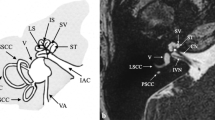Abstract
Traditionally, computed tomography (CT) is the primary radiographic method to analyze the morphology of the craniofacial bones: Because of the many overlapping anatomical structures, it is difficult and sometimes impossible to evaluate craniofacial bones three-dimensionally (3D) with these images. For this reason, the aim of this paper has been to evaluate and demonstrate the importance of CT scans integrated by three-dimensional reconstructions (3D-CT) volume rendering imaging for the accurate understanding of the nasal pyramid morphology in the evaluation of patients submitted to secondary rhinoseptoplasty. Twenty patients enrolled for a secondary rhinoseptoplasty, underwent a preoperative evaluation through 3D-CT volume rendering imaging. This technique allowed a prefect reconstruction of the nasal structures at the level of the valve, as well as the medial and lateral walls of the nasal fossa in all of its components (bone and cartilage). In our experience, the 3D-CT volume rendering imaging studies improve the preoperative evaluation of structures and anomalies which are hard to evaluate by the anterior rhinoscopy and/or nasal endoscopy: alar and lateral cartilages, interdomal distance, tip morphology, valvular configuration, loss of bone-cartilaginous substance, etc. All of these points are important during the preoperative planning of secondary rhinoseptoplasty.




Similar content being viewed by others
References
Mocella S, Bianchi N, Cerini R, Beltramello A (1996) Magnetic resonance imaging in primary and secondary septorhinoplasty. Facial Plast Surg 12:321–332
Gupta A, Brooks D, Stager S, Lindsey WH (2003) Surgical access to the internal nasal valve. Arch Facial Plast Sur 5:155–158
Corey JP, Gungor A, Nelson R, Fredberg J, Lai V (1997) A comparison of the nasal cross-sectional areas and volumes obtained with acoustic rhinometry and magnetic resonance imaging. Otolaryngol Head Neck Surg 117:349–354
Min YG, Jang YJ (1995) Measurement of cross-sectional area of the nasal cavity by acoustic rhinometry and CT scanning. Laryngoscope 105:757–759
Frigo AC, Procopio O, Peretta R, Scattolin G, Ferronato G (2010) Imaging of facial soft tissues in multislice computerized tomography: a new geometric method of analysis and its statistical validation. Oral Surg Oral Med Oral Pathol Oral Radiol Endod 110:101–109
Yu K, Kim A, Pearlman SJ (2010) Functional and aesthetic concerns of patients seeking revision rhinoplasty. Arch Facial Plast Surg 12:291–297
Mehta U, Mazhar K, Frankel AS (2010) Accuracy of preoperative computer imaging in rhinoplasty. Arch Facial Plast Surg 12:394–398
El-Mehallawi IH, Soliman EM (2001) Ultrasonic assessment of facial soft tissue thicknesses in adult Egyptians. Forensic Sci Int 117:99–107
Dos Santos DT, Costa e Silva AP, Vannier MW, Cavalcanti MG (2004) Validity of multislice computerized tomography for diagnosis of maxillofacial fractures using an independent workstation. Oral Surg Oral Med Oral Pathol Oral Radiol Endod 98:715–720
Luka B, Brechtelsbauer D, Gellrich NC, König M (1995) 2D CT and 3D CT reconstructions of the facial skeleton: an unnecessary option or a diagnostic pearl? Int J Oral Maxillofac Surg 24:76–83
Rhea JT, Rao PM, Novelline RA (1999) Helical CT and threedimensional CT of facial and orbital injury. Radiol Clin North Am 37:489–513
Carls FR, Schuknecht B, Sailer HF (1994) Value of three-dimensional computed tomography in craniomaxillofacial surgery. J Craniofac Surg 5:281–285
Tasman AJ, Helbig M (2000) Sonography of nasal tip anatomy and surgical tip refinement. Plast Reconstr Surg 105:2573–2576
Constantinian MB, Clardy RB (1996) The relative importance of septal and nasal valvular surgery in correcting airway obstruction in primary and secondary rhinoplasty. Plast Reconstr Surg 98:38–54
Pawar SS, Garcia GJ, Kimbell JS, Rhee JS (2010) Objective measures in aesthetic and functional nasal surgery: perspectives on nasal form and function. Facial Plast Surg 26:320–327
Schlosser RJ, Faust RA, Phillips CD, Gross CW (2002) Three-dimensional computed tomography of congenital nasal anomalies. Int J Pediatr Otorhinolaryngol 65:125–131
Conflict of interest
None of the authors have a financial relationship with any organization that sponsored the research.
Author information
Authors and Affiliations
Corresponding author
Rights and permissions
About this article
Cite this article
Graviero, G., Guastini, L., Mora, R. et al. The role of three-dimensional CT in the evaluation of nasal structures and anomalies. Eur Arch Otorhinolaryngol 268, 1163–1167 (2011). https://doi.org/10.1007/s00405-011-1575-1
Received:
Accepted:
Published:
Issue Date:
DOI: https://doi.org/10.1007/s00405-011-1575-1




